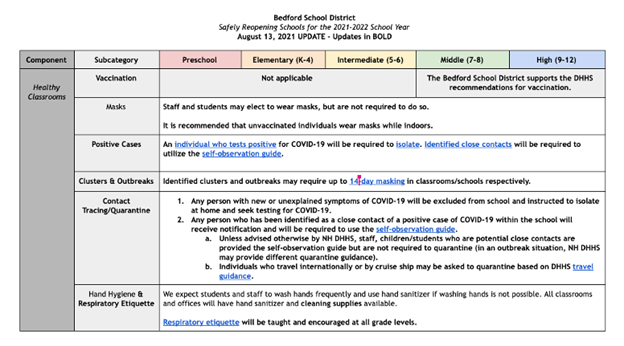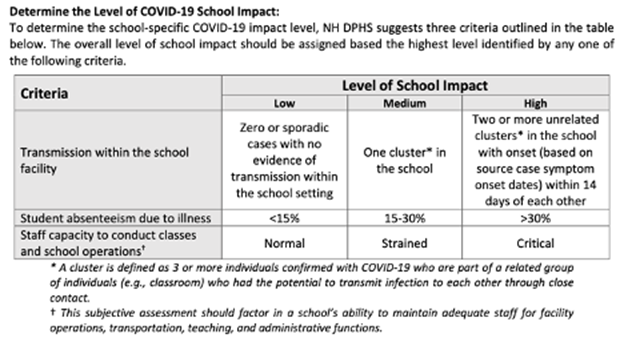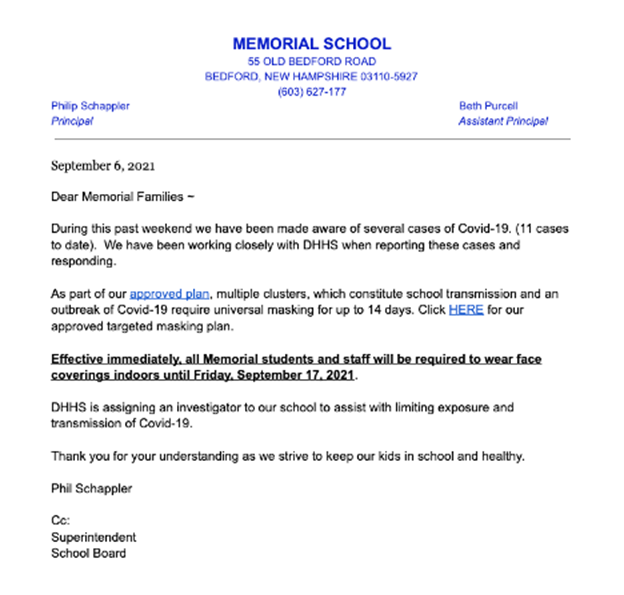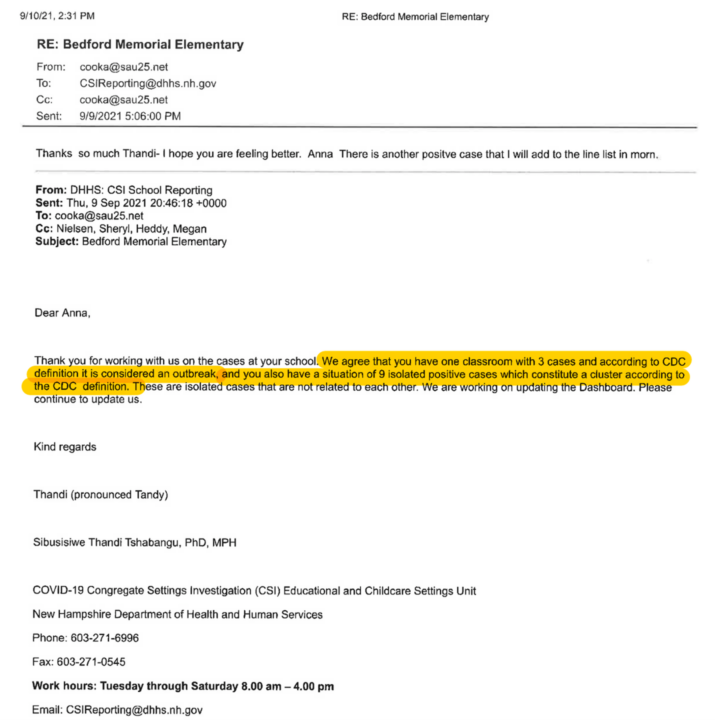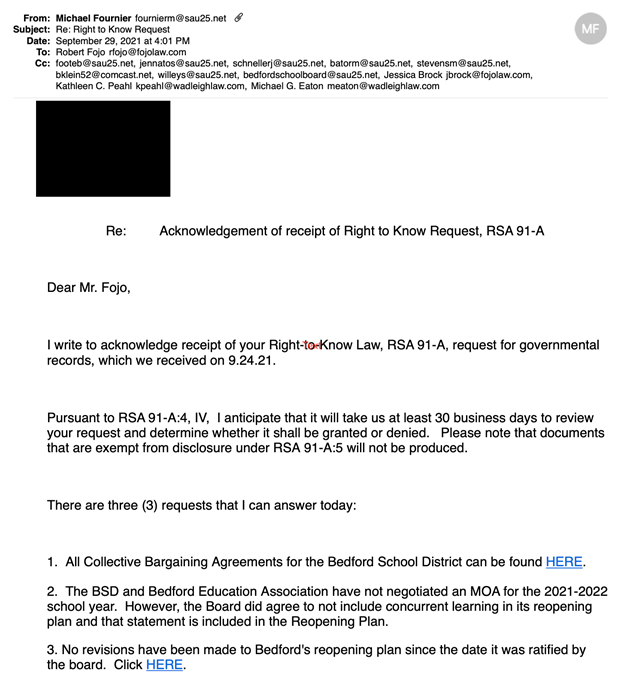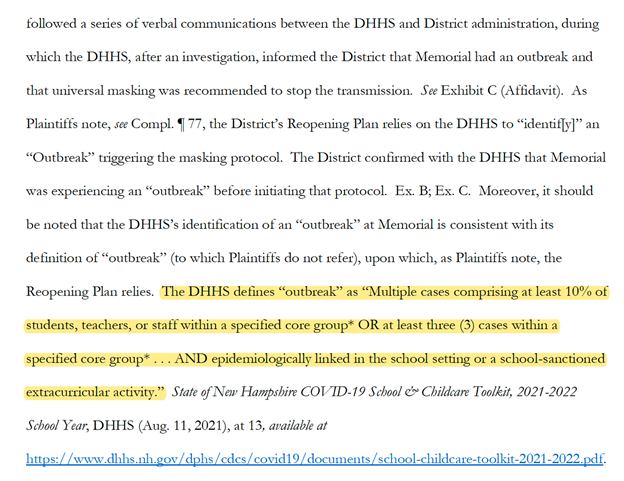As COVID measures continue to disappear, many people are drawing comfort from the possibility that their lives may finally be returning to normal. While that may be true, we need to continue to take note of what we lost throughout this two-year ordeal and learn how to prevent our federal, state, and local governments from implementing these measures again in the future.
Many state and local governments took advantage of the COVID-19 pandemic to make radical changes to our lives. When they made these changes, they often acted without transparency and without authority. New Hampshire presented numerous examples of this abuse of power in 2020 and 2021. A particularly glaring example of the lack of transparency in local governments occurred in the Bedford School District in September 2021.
In early September 2021, parents of children who attended Bedford Memorial School received an email from Principal Phil Schappler announcing that the school had identified an “outbreak” of COVID-19 (indicating there was “school transmission” of the virus) and, thus, would require, beginning the following day, universal masking for students for the next 14 days.
The school’s decision failed to follow the District’s Reopening Plan for 2021-2022, which dictated that an “outbreak” consisted of multiple instances of three or more confirmed COVID-19 cases in a classroom.
Mr. Schappler’s letter explained the school had identified just 11 cases at the time, but he failed to explain how those 11 cases constituted an “outbreak” under the District’s Reopening Plan. Rather, he conceded to several parents (which would later be confirmed) that the school did not have an “outbreak” or “school transmission” of any kind, and he further conceded the school had unilaterally – without holding a public meeting or providing notice of one – lowered the above threshold for identification of an “outbreak” (multiple instances of three or more confirmed cases in a classroom) to multiple instances of just two or more confirmed cases in a classroom.
Based on this arbitrary nonpublic decision, Memorial School officials then denied several children entry to school because they refused to wear masks and communicated they would continue to deny them entry for the ensuing 14 days unless and/or until they wore masks. To make matters worse, school officials failed to provide those children with an adequate substitute for educating them during that period of time.
Below is what happened in more detail, including an explanation of the New Hampshire Right-to-Know Law (the state’s public records law) and how and why the Bedford School District violated it.
The New Hampshire Right-to-Know Law
RSA 91-A requires all meetings of public bodies to have proper notice and be open to the public, and minutes must be kept for such meetings.
RSA 91-A:1-a, VI(d) defines a “public body” as “[a]ny legislative body, governing body, board, commission, committee, agency, or authority of any county, town, municipal corporation, school district, school administrative unit, chartered public school, or other political subdivision, or any committee, subcommittee, or subordinate body thereof, or advisory committee thereto.” A non-public session under RSA 91-A:3 may be held only in certain discreet circumstances.
Accordingly, the Right-to-Know Law applies to school districts and school boards.
Bedford School District’s 2020-2021 Reopening Plan
The District’s School Board approved a Reopening Plan on August 16, 2021, for the 2021-2022 school year. Under that Plan, masks were “[r]ecommended but not required for students ages 11 and under,” and the District “return[ed] to pre-covid operations” (i.e., masks were not required or recommended) for grades 7-12. Remote learning would be “only available to students as a result of an Individual Education Plan (IEP) or as a result of reasonable accommodations through a Section 504 Plan.”
The District adopted certain “mitigation measures,” however, to address any positive cases or outbreaks of COVID-19:
These measures stated that “[a]n individual who tests positive for COVID-19 will be required to isolate,” and “[i]dentified close contacts will be required to utilize the self-observation guide.” “Identified clusters and outbreaks,” however, “may require up to 14-day masking in classrooms/schools respectively.”
In the above document, the phrase “14-day masking” linked to a separate “Targeted Masking Plan,” which appeared to be a matrix for determining when/when not to require masking:
According to the Plan above (which relied on CDC guidance), an “outbreak” was defined as “multiple clusters within a school setting,” and referenced the New Hampshire Department of Health and Human Services (“DHHS”). If a Bedford school determined it had an “outbreak,” it had to “[i]nitiate mask wearing for up to 14 days in the school” (the entire school, not just any one classroom) and “[m]aintain quarantine protocol.”
At the time, DHHS defined a “cluster” as “3 or more individuals confirmed with COVID-19 who are part of a related group of individuals (e.g., classroom) who had the potential to transmit infection to each other through close contact”:
“Two or more unrelated clusters in the school with onset (based on source case symptom onset dates) within 14 days of each other” indicated there was “[t]ransmission within the school facility.”
Accordingly, under these guidelines and the District’s Reopening Plan, for a Bedford school to initiate universal mask-wearing for up to 14 days, it had to determine there were multiple instances of “3 or more individuals confirmed with COVID-19” in a “related group,” usually a classroom.
The District’s Non-Public Revision of its Reopening Plan for Memorial Elementary School
On Sunday, September 5, 2021, parents of children who attended Bedford Memorial School received the following letter by email from Principal Phil Schappler:
Mr. Schappler’s letter identified the school was “made aware” of “11 cases to date” of COVID-19. He labeled these cases “multiple clusters, which constitute school transmission and an outbreak of Covid-19” that “require[s] universal masking for up to 14 days.” The letter failed to explain whether the school actually identified multiple instances of “3 or more individuals confirmed with COVID-19” in a “related group” or a classroom.
The following morning, several parents brought their children to Memorial School without masks, and school officials, including Mr. Schappler, denied them entry and failed to provide any reasonable accommodations for the school’s abject refusal to admit the children. Memorial intended to continue denying those children entry to the school for the next 14 days unless and/or until they wore masks.
Some of the parents requested further information from Mr. Schappler concerning the school’s alleged “outbreak.” Mr. Schappler conceded they did not have “school transmission” of COVID-19, and they had not identified multiple clusters of confirmed cases in any one classroom. Rather, he explained the school unilaterally modified the matrix above whereby, instead of basing its identification of a “cluster” on “3 or more individuals confirmed with COVID-19” in a “related group,” it lowered the threshold for identifying a “cluster” to just two individuals in a “related group” or classroom.
The District had not had a school board meeting (or provided notice of one) at which it voted on and approved this change to its Reopening Plan, and there was no indication it held any public meeting to effectuate that change.
Rather, Mr. Schappler and the District ignored the Reopening Plan and had taken direction from DHHS: in a September 9 email, the District confirmed it was relying on the recommendation of a DHHS official that just “one classroom with 3 cases . . . is considered an outbreak.”
The District’s Targeting Masking Plan obviously did not set forth that definition. Indeed, that same email above confirmed the cases at Memorial were “9 isolated cases” “that are not related to each other,” and thus did not meet the definition of an “outbreak” in the Targeted Masking Plan. The District simply ignored that fact and followed the above-revised definition of an “outbreak” (“one classroom with 3 cases”).
September 13, 2021, Bedford School Board Meeting
At a District School Board meeting on September 13, 2021, District Superintendent Michael Fournier, nevertheless, insisted the Reopening Plan had not been revised. He stated, “[a]ny revisions [of the Reopening Plan] would be on the website. . . . No revisions have been made.” (approx. 1:01:00 of the video recording)
He would later confirm that fact in an email to me on September 29 (at the very bottom):
At the September 13, meeting, Mr. Fournier also conceded the District undertook the action, not him alone or some other administrator: he repeatedly used the pronoun “we” when explaining the decision to declare an “outbreak” at Memorial: “We were unclear on what would constitute an outbreak. . . . There are times when we receive information that isn’t always congruent. . . . If DHHS determines it’s an outbreak, then we mask up.” (approx. 3:10)
Mr. Fournier is certainly an “authority” of the District under the Right-to-Know Law. Accordingly, the actions above were not unilateral actions taken by a lone administrator (Mr. Fournier or Mr. Schappler); they were a collective action taken by the District.
Mr. Fournier also conceded above that the District followed a methodology for identifying an “outbreak” that was different than what the School Board voted to approve in the District’s Targeted Masking Plan above: he explained the District relied, instead, on the DHHS’s unilateral – and ever-changing – determination of what constituted an “outbreak,” and he further explained the information and determinations provided by DHHS “isn’t always congruent.”
Why the District Violated the Right-to-Know Law
The District violated RSA 91-A because it unilaterally modified its Reopening Plan outside a public school board meeting: in concert with DHHS, the District lowered the threshold number of cases upon which it relied for the identification of a “cluster” of cases in Bedford schools without holding a public meeting or providing notice of one. None of the circumstances justifying a nonpublic session under RSA 91-A:3 applied here.
The District later explained – through Mr. Schappler in a court filing – that this revision occurred in discussions outside a traditional school board meeting:
Our Lawsuit Challenging the District’s Action, the District’s Admission of Wrongdoing, and the Court’s Conclusion
Like other situations, we filed a lawsuit in New Hampshire Superior Court challenging the District’s decision to change its Reopening Plan and principally argued this modification violated the Right-to-Know Law.
In a motion to dismiss filed in response to the complaint, the District’s attorneys conceded the District’s Targeted Masking Plan defined an “outbreak” as “multiple clusters within a school setting.” The District also conceded it revised that Targeting Masking Plan: it re-defined the definition of an “outbreak” as “[m]ultiple cases comprising at least 10% of students, teachers, or staff within a specified core group* OR at least three (3) cases within a specified core group* . . . AND epidemiologically linked in the school setting or a school-sanctioned extracurricular activity.”
The District’s attorneys also included the email correspondence above with DHHS that confirmed this critical change. The District further conceded – consistent with Mr. Fournier’s statements at the September 13 School Board meeting – that this revision required confirmation by a DHHS official of an “outbreak.”
The District’s conduct was not an “implementation” of its “policy”; it was an outright revision of that very policy, and that revision significantly lowered the threshold for identifying an “outbreak.” It was now also abundantly clear that Mr. Fournier lied at the September 13 School Board meeting and in his September 29 email to me when he claimed the District’s Reopening Plan was not revised.
Nevertheless, after a hearing, the Court concluded (1) there was no change in the Reopening Plan, and — most astonishing — (2) the District’s actions were not actions of a public body subject to RSA 91-A.
These conclusions were obviously erroneous. As explained above, the District conceded it acted as a District (through discussions Mr. Fournier claims “we” undertook) to decide to implement a masking requirement in one of its schools; the District conceded it revised its Targeted Masking Plan; and the District conceded that revision did not occur at a public meeting.
The Court should not have reached these conclusions. Its approval of the District’s action unfortunately condoned the dictatorial actions of a school district that took place in private without any transparency or accountability to the general public.
This kind of government malfeasance often occurs in situations where people least pay attention. The parents in this instance thankfully caught it. Not surprisingly, however, the courts were not helpful in checking yet another instance of government overreach during the pandemic.

